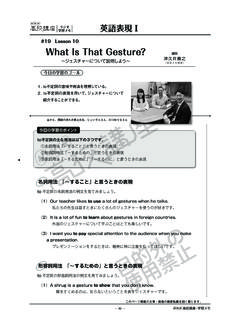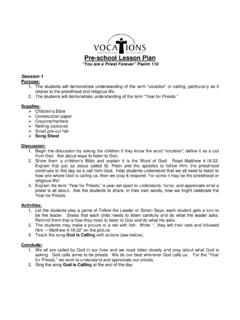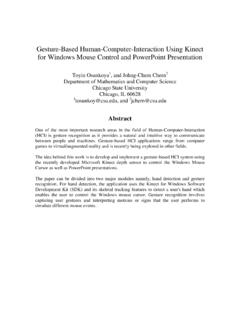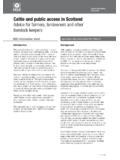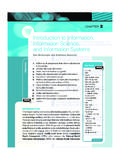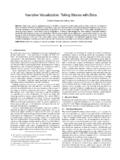Transcription of Gesture Drawing for Animation - Ron Doucet | Animation ...
1 Gesture Drawing for Animation Walt Stanchfield Edited by Leo Brodie ii Walt Stanchfield This compilation is not copyrighted or protected in any way by the editor of the compilation (Leo Brodie). It is based on a series of un-copyrighted class notes written by Animation instructor Walt Stanchfield during the period roughly from 1970 to 1990. Since then, these class handouts have been widely copied and shared amongst Animation students and members of the Animation industry with Mr. Stanchfield's blessing and encouragement; in that spirit, the handouts are now available freely on the Internet. Some of the illustrations in this book represent preliminary drawings of cartoon characters that are the properties of their respective copyright holder(s) and are therefore protected by copyright.
2 These illustrations were part of the original handouts and are included here for educational purposes to illustrate specific principles of Animation technique. No endorsement of this book by the copyright holder(s) is implied, nor do the views expressed in this book necessary reflect those of the copyright holders(s). I hope that covers it. Gesture Drawing for Animation iiiTable of Contents Chapter 1: Go for the , Observe, Lead to the Give Them the The Driving Force behind the Action ..5 Gesture ..9 The Essence ..10 Go For The Truth!..13 Chapter 2: The Animator's You Go ..17 Composition ..17 Ron Husband's Sketchbook ..21 Note Taking and Good Habits ..32 Chapter 3: A Visual Vocabulary for , Lines, Lines ..31 A Simple Approach to Drawing ..31 A Simple Approach to Drawing ..32 Finding the The Solid-Flexible Model ..32 Figure Sketching for Animation ..32 The Pipe Seeing in Three Dimensions ..34 The Rules of Perspective ..34 Direction ..36 Problems of Drawing in Simplifying Heads.
3 37 Caricatured Head Shapes ..37 The Head in Gesture ..38 A Simple Approach to Costumes and Chapter 4: The First Sketching ..71 Superficial Appearance vs. Creative Portrayal ..71 A New Phrase: Body Syntax ..72 The "Explosive" Feel, As Well As See, the Gesture ..76 Draw Verbs, Not Draw with a Purpose ..77 Dividing the Body into Units ..78 "Knowing" or Searching ..79 Simplicity for the Sake of Clarity ..79 Chapter 5: Elements of the and Applying Angles and Tension in Our ivWalt Stanchfield Tennis and Straight against Curve: Squash and Stretch in the Pose ..101 Applying Perspective ..103 The Sensation of Space ..105 Recreating the First Impression ..109 Putting the Elements of a Pose Together ..112 Habits to Avoid ..118 It Ain t Easy ..121 Chapter 6: Pushing the Gesture from the Model ..120 Stick to the Theme ..120 Subtlety ..123 Pushing the Gesture ..124 Gesture to Portray an Action or a Mood ..124 Action Analysis: Hands & Feet ..125 Learn to Lazy Double Vision.
4 125 Caricature ..125 Chapter 7: Principles of 28 Principles of Animation ..154 Drawing Calories ..154 The Pose Is an Animating Squash and The Opposing Connecting Chapter 8: A Sense of Sense of Story ..171 Talk To Your Audience - Through Drawing ..179 A Thinking Person's Art ..182 Acting and Drawing ..187 The Emotional Gesture ..187 Common Vs Uncommon Gestures ..188 Body Language ..189 Chapter 9: Final Energy ..191 A Bit of Introspection ..194 Mental and Physical Preparation ..195 The Metaphysical Habits ..197 Final Words on Gesture Drawing for Animation vForeword by the Editor Walt Stanchfield was an animator who taught life Drawing classes for animators with a special emphasis on Gesture Drawing . For each weekly class session, he wrote informal handouts to emphasize the theme of the current class session, to comment on work done in the previous class, or discuss whatever topic struck his fancy. Over a period of years, these notes were lovingly shared, studied, and treasured by animators and Animation students Stanchfield personally gave copies of his collection to interested students, and was happy to seem them distributed.
5 According to many people who were lucky enough to study under him, he wanted to publish them as a book, but the studio where he worked was not goal of this project is to imagine the book that Walt Stanchfield might have written. This project is a compilation of the first 60 handouts that are shared on the website (as that site has numbered them). Walt Stanchfield did not present his topics in any particular order, which suited the ongoing nature of the classes. Walt's handouts are like individual frames of Animation some are extremes, some are inbetweens, some are even cleanups. As I was reading the notes and trying to absorb as much as I could, I thought I might understand them better if it were all laid out in sequence, with basic topics followed by more complex ideas. I wanted to see his ideas grouped by subject so I could compare the ideas. In other words, I wanted the topics to be arranged like a normal book. So I've re-arranged bits and pieces from the handouts into cohesive chapters, while taking the liberty to eliminate redundancy and make minor edits just as a book editor deciding how to organize the material, I imagined how Walt himself would have put it together if he'd written it.
6 Where would he have started? Knowing that the readers of the book would not be the lucky members of his classes, what concepts would have illustrated before moving on to more advanced topics? I tried to follow the principles Walt himself outlines in these notes: clarity, attention to the "essence," emotion, and using the minimum number of words (lines) to get the point across. Another reason I wanted to see this material as a book is that there is no other book that covers the same information. There are many excellent volumes on Animation , but they generally assume that the reader can already draw animatable characters with strong poses without explaining how to get to that stage. All the books on generic figure and life Drawing , even those that emphasize Gesture , encourage capturing the model's appearance and Gesture without explaining how to internalize the Gesture so as to push it to extremes or apply it to a different figure. Personally, I think this compilation if it were a book would take its place among the top volumes on Animation .
7 There is an informal, lively charm to the original handouts that gives the reader a sense of 'being there.' You may want to check them out to get a feel for how this information was viWalt Stanchfield originally presented. I've left "Savvy Sayings" (#47 in the collection) out of this book, so it remains a delight that you can seek out on your own. Many, many thanks to Jon Hooper and Steve Kellener of for scanning and transcribing many of Walt's notes and making them available on their Web site. This book incorporates their scans and OCR conversions, so it would not exist without their efforts. Thanks also to Aimee Major Steinberger, who was, I believe, the first person to post one of the Walt's notes on the Internet. -- Leo Brodie Seattle, Washington Gesture Drawing for Animation viiAbout Walt Stanchfield Walt Stanchfield was born in 1919 in Los Angeles, California. He is listed as animator on Winnie the Pooh and the Blustery Day, The Many Adventures of Winnie the Pooh, The Rescuers, The Fox and the Hound (coordinating animator), Micky's Christmas Carol (creative collaboration), The Black Cauldron (key Animation coordinator), The Great Mouse Detective (coordinating animator), Roger Rabbit ( Animation consultant) and Oliver & Company (production assistant).
8 He continued with Disney in later years, advising and teaching classes. Mr. Stanchfield died September 3, 2000. viiiWalt Stanchfield From the October 2000 Peg-Board Once in a lifetime, a truly special teacher comes along who can change your life forever. To me and to many, many of our colleagues in the industry, Walt Stanchfield was that very special teacher. Part artist, part poet, part musician, part tennis pro, part eccentric savant, part wizened professor, Walt inspired a generation of young artists not only with his vast understanding of the animator's craft, but with his enthusiasm and love of life. Walt started in the Animation industry at Mintz in 1937. He also worked for two years at Lantz. In 1948 he went to work for Disney and with the exception of four short retirements, had worked there ever since. Walt worked on every full-length cartoon feature from The Adventures of Ichabod Crane and Mr. Toad (1949) to The Great Mouse Detective (1986). Throughout those years Walt developed an insatiable enthusiasm for teaching the craft.
9 He supported his numerous Drawing classes with weekly hand-outs that taught not only Animation and Drawing principles, but philosophy, attitude and life 's personal work was full of vitality. He was a tireless sketcher, a painter of landscapes, seascapes, still lifes and people. He was an avid writer, penning hundreds of pages of notes about the art of Animation as well as poetry and stories. He also loved music and spent an inordinate amount of time at the piano - that is, between caring for his vegetable garden and playing his most beloved game: tennis. Walt has touched many lives, not only with his endless enthusiasm for Animation but with his love of life, art and people. His work will live on forever in the hands and hearts of his students and we will all miss him. -- Don Hahn Gesture Drawing for Animation ixIntroduction (In the Words of Walt Stanchfield) Have you ever said, Oh, if I could just draw well ? Ah, yes, you could express yourself to the nth degree.
10 You could animate or cleanup scenes that would evoke oohs and wouldn t be so much like work. You could get it all down on paper and leave at 5:00 o clock feeling I wish I had a magic wand that I could wave over you and say, You are now learned artists go and draw to your hearts content. But maybe it s better that you do it yourself become your own self-starter. The learning process should be fun. One thing that it does is it tears down a lot of false pride. To seek help is a humbling experience, a very necessary one, in as much as Animation should be thought of and practiced as a group effort. I consider a person who is not ashamed to seek help a wise person. I got a late start in life. The first five or six years in the business were a walk through. (I started at Mintz s Cartoon Studio on Sept. 13, 1937.) I was a dilettante, toying with poetry, painting, singing and socializing. Then 10 years as Lounsbery s assistant, and 10 years as Johnston s assistant helped me to center myself.
